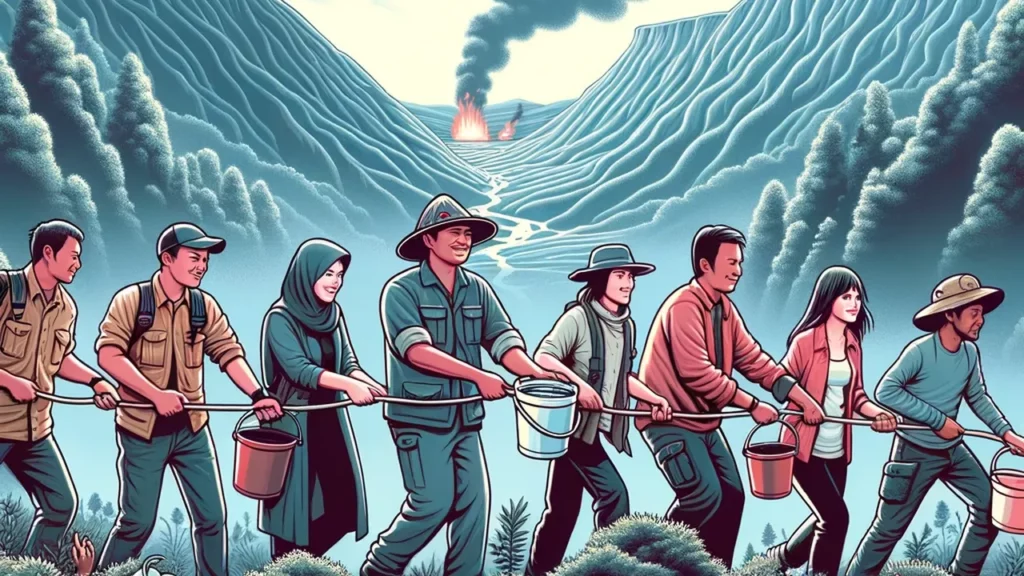In September, the serene landscape of Bromo was disrupted by a devastating fire, marking a critical moment for local tourism and community effort. This incident, known as “Bromo Firefighting,” saw an extraordinary collective response as tourism operators and local residents united to combat the flames. Their concerted efforts highlight the resilience and solidarity within the community, setting a powerful example of collaboration in the face of adversity. The story of Bromo’s firefighting is not just about battling a blaze, but also about the spirit of communal support and the essential role of local initiatives in preserving natural and economic wellbeing.
United Efforts in Disaster
The Bromo Firefighting incident in September stood as a testament to the power of collective action in the face of a natural disaster. Community members from various walks of life, including tourism operators, local farmers, and volunteers, came together in an impressive display of unity. This collaboration was essential in tackling the rapidly spreading fire, which threatened not only the natural landscape but also the livelihoods dependent on the tourism industry.
“In unity, we found strength to overcome adversity together.”
Local efforts were instrumental in coordinating the firefighting strategies. Using limited resources, the community improvised with tools at hand, such as branches and makeshift water hoses, to contain the fire. Their knowledge of the terrain and the wind patterns played a crucial role in preventing the fire from causing further damage.
The response to the fire also saw a remarkable level of coordination between the local community and government authorities. Firefighters, police, and forest rangers worked alongside the residents, sharing expertise and resources. This synergy between different groups ensured a more effective and timely response to the crisis.
Tourism Sector’s Heroic Role
The tourism sector in Bromo played a pivotal role during the firefighting efforts, showcasing an inspiring example of heroism and dedication. Local tourism operators, who were deeply affected by the fire, did not hesitate to put their daily activities on hold to join the fight against the flames. Their intimate knowledge of the local geography and terrain proved invaluable in navigating the challenging landscape during the firefighting efforts.
Guides, hotel owners, and even souvenir vendors transformed into front-line firefighters, demonstrating an unwavering commitment to protecting their community. They worked tirelessly, day and night, forming human chains to pass buckets of water and using whatever tools they had to douse the flames. Their efforts were not just about protecting their businesses, but also about preserving the natural beauty of Bromo for future generations.
“Tourism heroes emerged, uniting to shield Bromo’s beauty and legacy.”
This remarkable response underscored the deep connection between the tourism sector and the well-being of the Bromo region. The sector’s swift and selfless response in a time of crisis highlighted the critical role it plays not just in the economy, but also in the social and environmental fabric of the community.
Reviving Bromo After the Blaze
In the aftermath of the fire, the focus swiftly shifted to the restoration of Bromo, a task that demanded as much commitment as the firefighting itself. Community members, once firefighters, now turned their hands to rejuvenation, planting new vegetation and repairing damaged trails. This effort was crucial not only for the environment but also for reviving the tourism upon which so many livelihoods depend.
“From ashes, Bromo rose again, nurtured by hands of hope and unity.”
The local government, along with environmental and tourism organizations, launched initiatives to support the recovery process. Fundraisers and awareness campaigns were set up, attracting support from across the nation. These efforts ensured that the necessary resources were available for the extensive restoration work required.
Educational programs were also introduced to prevent future disasters, emphasizing the importance of sustainable tourism and environmental stewardship. Local schools and community centers became hubs for learning about fire prevention, conservation, and the delicate balance of the ecosystem. The goal was to embed a culture of respect and care for the natural world within the community.
The story of Bromo’s battle against and recovery from the devastating fire is a profound example of community effort in action. It showcases how a collective response, fueled by the dedication and resilience of local communities, tourism operators, and government authorities, can overcome even the most challenging disasters. This saga not only highlights the strength and unity of the community in times of crisis but also underscores the importance of sustainable practices and environmental stewardship. Ultimately, the experience at Bromo serves as a reminder of the power of community effort in protecting and nurturing our natural world, ensuring its preservation for future generations.

